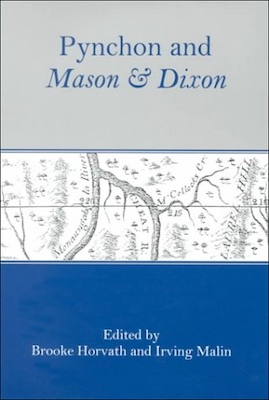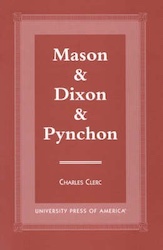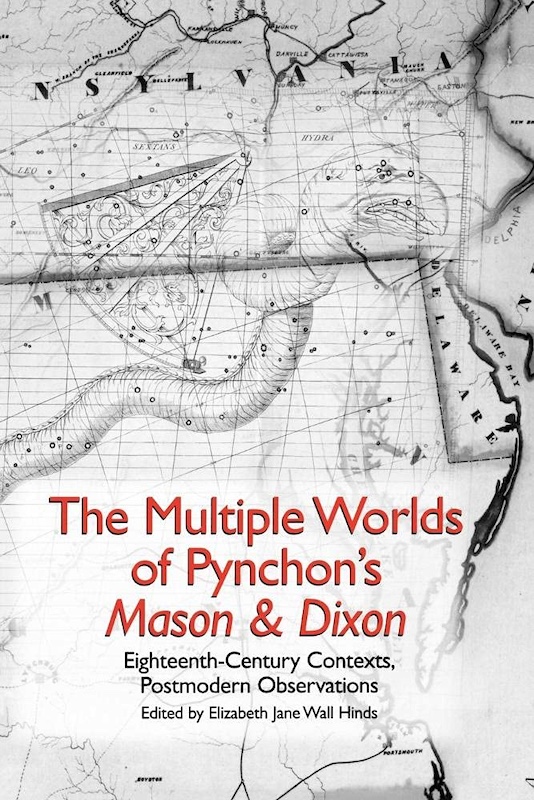Pynchon Criticism: “Mason & Dixon”

All the way back to the Visto, Mason is seiz’d by Monology. “Text,—” he cries, and more than once, “it is Text,—and we are its readers, and its Pages are the Days turning. Unscrolling, as a Pilgrim’s Itinery map in ancient Days…”
—“Mason & Dixon”
Pynchon Criticism: Mason & Dixon
This page collects essays, analysis, and guides centering on
Mason & Dixon, Pynchon’s fifth novel, published in 1997. Most of the books profiled in this section are accompanied by a brief description, a summary of contents, and the official publisher’s blurb. If any visitor would like to contribute informed commentary for any of these works, please
contact Spermatikos Logos! The books are listed in chronological order of publication. Clicking the image of a book takes you directly to Amazon.
Pynchon and Mason & Dixon
Brooke Horvath & Irving Malin, ed.
University of Delaware Press, 2000.
The first collection of scholarship on Mason & Dixon, this book contains eleven essays on Pynchon’s epic text, narrative style, and historical resources.
Publisher’s Description: For Thomas Pynchon, history has been a conspiracy of warring factions whose business is trade and death and whose most ominously magic-haunted weapons include science and technology. Throughout history, those in power have conjured nightmares while simultaneously denying what everywhere percolates behind and beyond them: ghostly signs and wonders, mystery and madness, sinister machinations.
Asking who or what makes history, how and towards what ends, Mason & Dixon is the novel Pynchon’s readers have been waiting for since Gravity’s Rainbow shattered the literary calm almost a quarter-century ago. This volume gathers eleven essays by some of today’s most prominent critics. While orienting readers new to Pynchon, the essays also prepare the way for further discussion, locating Mason & Dixon within the context of Pynchon’s earlier work and of contemporary American fiction to delineate what Brian McHale terms the “poetics of Pynchon-space.” For McHale, Pynchon’s America is always a subjunctive space of wish and desire: the novel that Irving Malin, closely reading the intricate wordplay of the opening paragraph, deems uncertain “counterhistory.”
For Arthur Saltzman, Donald J. Greiner, and David Seed, the novel’s import resides in the line Charles Mason and Jeremiah Dixon charted through the American wilderness—a symbol, says Saltzman, of the Enlightenment’s belief in a divinely sanctioned universe, which Pynchon reveals to be a “clockwork universe” of infinite peril. For Greiner, such impositions of order upon “pristine complexity” helped shatter the ideals upon which America was founded. For Seed, the Line represents an imperialist politics indifferent to all causualities left in its wake.
Victor Strandberg takes exception to Pynchon’s subversive reading of western history, attributing it to his “hippie” rebellion “against tradition, convention, and all forms of social hierarchy.” Joseph Dewey finds the novel looking East to reveal not only traces of a Beat-countercultural inheritance but a spiritual alternative to the secular nightmare the novel otherwise depicts. Bernard Duyfhuizen argues that the narrative instability serves here to question the authority and reliability of those who give history its meaning and shape.
David Foreman examines those historical documents Pynchon may have used in researching his story, and concludes that Pynchon wishes us to see history as inevitably “a construction.” Jeff Baker likewise examines the factual accuracy of Mason & Dixon to assess Pynchon’s conviction that revolutionary rhetoric was a “smokescreen” for the economic woes of a colonial elite. Finally, Thomas H. Schaub explores how the novel reveals Pynchon’s politics diminished to a “forgiving pastoralism.”
This foray into Mason & Dixon concludes with Clifford S. Mead’s bibliography of all material published to date about the novel.
Contents:
- Brooke Horvath: Introduction
- Irving Malin, “Foreshadowing the Text”
- Brian McHale, “Mason & Dixon in the Zone, or, a Brief Poetics of Pynchon-Space”
- Arthur Saltzman, “Cranks of Ev’ry Radius: Romancing the Line in Mason & Dixon”
- Donald J. Greiner, “Thomas Pynchon and the Fault Lines of America”
- David Seed, “Mapping the Course of Empire in the New World”
- Victor Strandberg, “Dimming the Enlightenment: Thomas Pynchon’s Mason & Dixon”
- Joseph Dewey,“The Sound of One Man Mapping: Wicks Cherrrycoke and the Eastern (Re)Solution”
- Bernard Duyfhuizen,“Reading at the ‘Crease of Credulity’”
- David Foreman,“Historical Documents Relating to Mason & Dixon”
- Jeff Baker,“Plucking the American Albatross: Pynchon’s Irrealism in Mason & Dixon”
- Thomas H. Schaub, “Plot, Ideology, and Compassion in Mason & Dixon”
- Clifford S. Mead, “Mason & Dixon Bibliography”
Mason & Dixon & Pynchon
Charles Clerc
University Press of America, 2000.
Publisher’s Description: Charles Clerc’s Mason & Dixon & Pynchon is the first book-length critical study of Thomas Pynchon’s latest novel. Clerc’s study approaches the novel from a variety of perspectives, including historical and literary. Substantial attention is paid to the historical time period of Mason & Dixon. A survey of over 50 critical responses to the book and excerpts from the journal of Mason and Dixon are also included.
Immanence & Transcendence in Thomas Pynchon’s Mason & Dixon: A Phenomenological Study
Joakim Sigvardson
Almqvist & Wiksell International, 2002.
Publisher’s Description: The investigation studies Thomas Pynchon’s Mason & Dixon as a novel that comes to giveness in terms of three strata of manifestation: the arty, the rhizomatic, and the acosmic. Utilizing a affective turn implemented within the phenomenological movement by Michael Henry, the study proposes that alongside a rhizomatic mode of accessibility promoting transcendence, Mason & Dixon manifests a withholding of transcendence. The study investigates the manifestation of this ontological withholding by carrying out the phenomenological reduction established by Edmund Husserl, and by elucidating the phenomenon of immanence in the literary text by means of a theory of auto-affection rooted in—but not reducible to—such methodological reduction. The study proposes that the thematization of anomaly in Mason & Dixon may be unconstructed by means of phenomenological moves that uncover strata of phenomenalization that are not apparent on a thematic or merely playful level. These strata, with their promotion of immanence at the expense of transcendence, are found to be complexly affective in nature. The affectivity governing the withholding of transcendence in these strata is discovered to be instrumental in the work’s critique of colonial modes of spatialization, of logocentric modes of transcendence, and of post-Nietzschean modes of affective mastery. Mason & Dixon discloses a tension between a mode of anomaly that is part of a normal/anomalous dichotomy and a mode of anomaly that is doubly anomalous. Manifested as a nonspatial zone, the doubly anomalous becomes manifested on the hither side of oppositional structures in the novel, such as truth/untruth. The doubly anomalous in Mason & Dixon is identified as an “acosmic” zone of affectivity in which mastering intellectualizations fall short of their telos. Insofar as the “acosmic” occurs within logocentric cartography, it implies an unsettling of every horizontal subject, of nature as the property of man, and of freeplay as the medium of will to power.
The Multiple Worlds of Pynchon’s Mason & Dixon
Elizabeth Jane Wall Hinds, editor
Camden House, 2009.
Publisher’s Description: Thomas Pynchon’s 1997 novel Mason & Dixon marked a deep shift in Pynchon’s career and in American letters in general. All of Pynchon’s novels had been socially and politically aware, marked by social criticism and a profound questioning of American values. They have carried the labels of satire and black humor, and “Pynchonesque” has come to be associated with erudition, a playful style, anachronisms and puns—and an interest in scientific theories, popular culture, paranoia, and the “military-industrial complex.” In short, Pynchon’s novels were the sine qua non of postmodernism; Mason & Dixon went further, using the same style, wit, and erudition to re-create an 18th century when “America” was being formed as both place and idea. Pynchon’s focus on the creation of the Mason-Dixon Line and the governmental and scientific entities responsible for it makes a clearer statement than any of his previous novels about the slavery and imperialism at the heart of the Enlightenment, as he levels a dark and hilarious critique at this America. This volume of new essays studies the interface between 18th- and 20th-century culture both in Pynchon’s novel and in the historical past. It offers fresh thinking about Pynchon’s work, as the contributors take up the linkages between the 18th and 20th centuries in studies that are as concerned with culture as with the literary text itself. Contributors: Mitchum Huehls, Brian Thill, Colin Clarke, Pedro Garcia-Caro, Dennis Lensing, Justin M. Scott Coe, Ian Copestake, Frank Palmeri.
 0
0 




